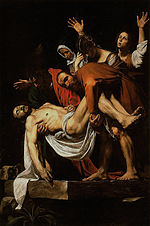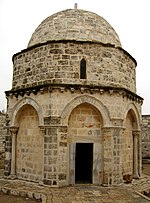Ascension of Jesus
Jesus' ascension to heaven depicted by John Singleton Copley, 1775
| Events in the |
| Life of Jesus according to the Gospels |
|---|
 |
|
Portals: |
In Christian art, the ascending Jesus is often shown blessing an earthly group below him, signifying the entire Church.[5] The Feast of the Ascension is celebrated on the 40th day of Easter, always a Thursday;[3] the Orthodox tradition has a different calendar up to a month later than in the Western tradition, and while the Anglican communion continues to observe the feast, most Protestant churches have abandoned the observance.[6][7]
Contents
Biblical accounts
| Part of a series on |
| Death and Resurrection of Jesus |
|---|
 |
|
Portals: |
The Gospel of John has three references to ascension in Jesus' own words: "No one has ascended into heaven but he who descended from heaven, the son of man" (John 3:13); "What if you (the disciples) were to see the son of man ascending where he was before?" (John 6:62); and to Mary Magdalene after his resurrection, "Do not hold me, for I have not yet ascended to my father..." (John 20:17).[1] In the first and second Jesus is claiming to be the apocalyptic "one like a son of man" of Daniel 7;[11] the last has mystified commentators – why should Mary be prohibited from touching the risen but not yet ascended Christ, while Thomas is later invited to do so?[12]
Various epistles (Romans 8:34, Ephesians 1:19-20, Colossians 3:1, Philippians 2:9-11, 1 Timothy 3:16, and 1 Peter 3:21-22) also refer to an ascension, seeming, like Luke-Acts and John, to equate it with the post-resurrection "exaltation" of Jesus to the right hand of God.[13] There is a broad consensus among scholars that the brief ascension account in the Gospel of Mark (Mark 16:19) is a later addition to the original version of that gospel.[14]
Background
Theologian James Dunn describes the ascension as at best a puzzle and at worst an embarrassment for an age which no longer conceives of a physical heaven located above the Earth.[15] The cosmology of the author of Luke-Acts was quite different: his age believed in a three-part cosmos with the heavens above, a flat earth centered on Jerusalem in the middle, and the underworld below.[16][17] Heaven was separated from the earth by the firmament, the visible sky, a solid inverted bowl where God's palace sat on pillars in the celestial sea.[18] Humans looking up from earth saw the floor of heaven, made of clear blue lapis-lazuli (Exodus 24:9-10), as was God's throne (Ezekiel 1:26).[19]Ascension stories were fairly common around the time of Jesus and the gospel-authors,[20] signifying the deification of a noteworthy person (usually a Roman Emperor), and in Judaism as an indication of divine approval.[21] Another function of heavenly ascent was as a mode of divine revelation reflected in Greco-Roman, early Jewish, and early Christian literary sources, in which particular individuals with prophetic or revelatory gifts are thought to have experienced a heavenly journey during which they learned cosmic and divine secrets.[21] Figures familiar to Jews would have included Enoch (from the Book of Genesis and a popular non-Biblical work called 1 Enoch); the 5th-century sage Ezra; Baruch the companion of the prophet Jeremiah (from a work called 2 Baruch, in which Baruch is promised he will ascend to heaven after 40 days); Levi the ancestor of priests; the Teacher of Righteousness from the Qumran community; the prophet Elijah (from 2 Kings); Moses, who was deified on entering heaven; and the children of Job, who according to the Testament of Job ascended heaven following their resurrection from the dead.[22][23] Non-Jewish readers would have been familiar with the case of the emperor Augustus, whose ascent was witnessed by Senators; Romulus the founder of Rome, who, like Jesus, was taken to heaven in a cloud; the Greek hero Heracles (Hercules); and others.[13]
Christian theology
Orthodox Feast of the Ascension
Liturgy: Feast of the Ascension
The Ascension, Dosso Dossi, 16th century.
In Christian art
The ascension has been a frequent subject in Christian art.[24] By the 6th century the iconography of the ascension had been established and by the 9th century ascension scenes were being depicted on domes of churches.[25][26] The Rabbula Gospels (c. 586) include some of the earliest images of the ascension.[26] Many ascension scenes have two parts, an upper (Heavenly) part and a lower (earthly) part. The ascending Christ may be carrying a resurrection banner or make a sign of benediction with his right hand.[27] The blessing gesture by Christ with his right hand is directed towards the earthly group below him and signifies that he is blessing the entire Church.[5] In the left hand, he may be holding a Gospel or a scroll, signifying teaching and preaching.[5]The Eastern Orthodox portrayal of the ascension is a major metaphor for the mystical nature of the Church.[28] In many Eastern icons the Virgin Mary is placed at the center of the scene in the earthly part of the depiction, with her hands raised towards Heaven, often accompanied by various Apostles.[28] The upwards-looking depiction of the earthly group matches the Eastern liturgy on the Feast of the Ascension: "Come, let us rise and turn our eyes and thoughts high ..."[5]
Gallery
Olivet and the Chapel of the Ascension
The Ascension edicule
Close-up of the Rock of the Ascension inside the Ascension edicule
Around the year 390 a wealthy Roman woman named Poimenia financed construction of the original church called "Eleona Basilica" (elaion in Greek means "olive garden", from elaia "olive tree," and has an oft-mentioned similarity to eleos meaning "mercy"). This church was destroyed by Sassanid Persians in 614. It was subsequently rebuilt, destroyed, and rebuilt again by the Crusaders. This final church was later destroyed by Muslims, leaving only a 12x12 meter octagonal structure (called a martyrium—"memorial"—or "Edicule") that remains to this day.[citation needed] The site was ultimately acquired by two emissaries of Saladin in the year 1198 and has remained in the possession of the Islamic Waqf of Jerusalem ever since. The Russian Orthodox Church also maintains a convent of the ascension on the top of the Mount of Olives.
See also
- Ascension Parish
- Assumption of Mary
- Chronology of Jesus
- Church of the Ascension (disambiguation)
- Life of Jesus in the New Testament
- Post-Resurrection appearances of Jesus
- Rapture
- Session of Christ
- Transfiguration of Jesus
References
Citations
- Nes 2005, p. 87.
Works cited
- Aune, David (2003a). "Ascent, heavenly". The Westminster Dictionary of New Testament and Early Christian Literature and Rhetoric. Westminster John Knox Press. ISBN 9780664219178.
- Baggley, John (2000). Festival Icons for the Christian Year. St Vladimir's Seminary Press. ISBN 9780881412017.
- Becchio, Bruno; Schadé, Johannes P. (2006). "Ascension". Encyclopedia of World Religions. Foreign Media Group. ISBN 9781601360007.
- Cresswell, Peter (2013). The Invention of Jesus: How the Church Rewrote the New Testament. Duncan Baird Publishers. ISBN 9781780286211.
- Cross, F.L.; Livingstone, Elizabeth A. (2005). "Ascension". The Oxford Dictionary of the Christian Church. Oxford University Press. ISBN 9780192802903.
- Earls, Irene (1987). Renaissance Art: A Topical Dictionary. ABC-CLIO. ISBN 9780313246586.
- Farrow, Douglas (2004). Ascension And Ecclesia. A&C Black. ISBN 9780567083258.
- Holwerda, D.E. (1979). "Ascension". In Bromiley, Geoffrey (ed.). The International Standard Bible Encyclopedia. Eerdmans. ISBN 9780802837813.
- Jensen, Robin M. (2008). "Art in Early Christianity". In Benedetto, Robert; Duke, James O. (eds.). The New Westminster Dictionary of Church History. Westminster John Knox Press.
- Köstenberger, Andreas J. (2004). John. Baker Academic. ISBN 9780801026447.
- McDonald, Lee Martin (2004). "Acts". In Combes, Isobel A. H.; Gurtner, Daniel M. (eds.). Bible Knowledge Background Commentary. David C Cook. ISBN 9780781440066.
- Müller, Mogens (2016). "Acts as biblical rewriting of the gospels and Paul's letters". In Müller, Mogens; Nielsen, Jesper Tang (eds.). Luke's Literary Creativity. Bloomsbury. ISBN 9780567665836.
- Munoa, Phillip (2000). "Ascension". In Freedman, David Noel; Myers, Allen C. (eds.). Eerdmans Dictionary of the Bible. Eerdmans. ISBN 9789053565032.
- Najman, Hindy (2014). Losing the Temple and Recovering the Future: An Analysis of 4 Ezra. Cambridge University Press. ISBN 9781139915847.
- Nes, Solrunn (2005). The Mystical Language of Icons. Eerdmans. ISBN 9780802829160.
- Ouspensky, Léonide; Lossky, Vladimir (1999). The Meaning of Icons. St Vladimir's Seminary Press. ISBN 9780913836774.
- Pennington, Jonathan T. (2007). Heaven and earth in the Gospel of Matthew. BRILL. ISBN 978-9004162051.
- Quast, Kevin (1991). Reading the Gospel of John. Paulist Press. ISBN 9780809132973.
- Quast, Kevin (2011). "Ascension Day". In Melton, J. Gordon (ed.). Religious Celebrations: An Encyclopedia of Holidays, Festivals, Solemn Observances, and Spiritual Commemorations. ABC-CLIO. ISBN 9781598842050.
- Seim, Turid Karlsen (2009). "The Resurrected Body in Luke-Acts: The Significance of Space". In Seim, Turid Karlsen; Økland, Jorunn (eds.). Metamorphoses: Resurrection, Body and Transformative Practices in Early Christianity. Walter de Gruyter. ISBN 9783110202991.
- Stokl-Ben-Ezra, Daniel (2007). "Parody and Polemics on Pentecost". In Gerhards, Albert; Leonhard, Clemens (eds.). Jewish and Christian Liturgy and Worship. BRILL. ISBN 9789047422419.
- Thompson, Richard P. (2010). "Luke-Acts: The Gospel of Luke and the Acts of the Apostles". In Aune, David E. (ed.). The Blackwell Companion to The New Testament. Wiley–Blackwell. ISBN 9781444318944.
- Wright, J. Edward (2002). The Early History of Heaven. Oxford University Press. ISBN 9780198029816.
- Zwiep, Arie W. (2016). "Ascension scholarship past present and future". In Pao, David W.; Bryan, David K. (eds.). Ascent into Heaven in Luke-Acts: New Explorations of Luke's Narrative Hinge. Fortress Press. ISBN 9781506418964.
Further reading
- Aune, David (2003b). "Cosmology". The Westminster Dictionary of New Testament and Early Christian Literature and Rhetoric. Westminster John Knox Press. ISBN 9780664219178.
- Burkett, Delbert (2002). An introduction to the New Testament and the origins of Christianity. Cambridge University Press. ISBN 9780521007207.
- Charlesworth, James H. (2008). The Historical Jesus: An Essential Guide. Abingdon Press. ISBN 9781426724756.
- Collins, Adela Yarbro (2000). Cosmology and Eschatology in Jewish and Christian Apocalypticism. BRILL. ISBN 978-9004119277.
- Dawson, Gerrit (2004). Jesus Ascended: The Meaning of Christ's Continuing Incarnation. Bloomsbury. ISBN 9780567119872.
- Farrow, Douglas (2011). Ascension Theology. Bloomsbury. ISBN 9780567651884.
- Hurtado, Larry W. (2005). Lord Jesus Christ: Devotion to Jesus in Earliest Christianity. Eerdmans.
- Knight, Douglas A.; Levine, Amy-Jill (2011). The Meaning of the Bible: What the Jewish Scriptures and Christian Old Testament Can Teach Us. HarperCollins.
- Lee, Sang Meyng (2010). The Cosmic Drama of Salvation. Mohr Siebeck. ISBN 9783161503160.
- Lincoln, Andrew (2004). Paradise Now and Not Yet. Cambridge University Press. ISBN 9780521609395.
- Packer, J.I. (2008). Affirming the Apostles' Creed. Crossway. ISBN 9781433522017.
- Park, Eung Chun (2003). Either Jew Or Gentile: Paul's Unfolding Theology of Inclusivity. Westminster John Knox Press. ISBN 9780664224530.
- Vermes, Geza (2001). The Changing Faces of Jesus. Penguin UK. ISBN 9780141912585.
- Zwiep, Arie W. (1997). The Ascension of the Messiah in Lukan Christology. BRILL. ISBN 978-9004108974.













